This Friday, January 26, is Australia Day, and that means it’s argument week down under. Crack open a tinny and celebrate with a very rare Punk Philatelist Longread!
Australia Day is Australia’s national day. It’s called Australia Day because obviously the names of all the other countries were already taken. Australia Day has been celebrated on many different dates in different regions in different eras, but it’s only since 1994 that it’s been uniformly observed on January 26.
We maybe should’ve thought that one through.
Previously, on Australia…
Quick history lesson. The Australian continent has been home to over 500 nations of Aboriginal Australians for what is now estimated at up to 65,000 years.
One day – specifically January 26, 1788 – the British showed up and established their first outpost in the land (we call it Sydney now). Other British colonies followed, and in 1901, they federated to become the nation you know as Australia.
January 26, 1788, therefore marks the first day of – what to call it? Good question. Colonisation, usurpation, settlement, invasion, occupation, civilisation… political battles rage over the terminology, but the indisputable end result was the dispossession of the indigenous peoples, with enormous disruption to family, culture, and language.
Also, the deaths. The stats are hard to pin down, but likely tens of thousands of the land’s traditional owners were killed – sometimes insidiously, by introduced diseases, but often in conflict, and on too many occasions, through sheer cold-blooded murder. The deaths weren’t all one-way. But the stats aren’t exactly equal.
(Historians are piecing together details of the killings that took place as European occupation expanded. This impressive interactive map compiled by the University of Newcastle is trying to record what we know. Zoom in, pick a dot, and learn. I particularly urge Australian readers to take a look, remembering that this is not ancient history. This has all taken place within the last 230 years.)
How are you doing? OK? Hang in there. I’ll be back to talking about the stamps soon.
Date wars
So there’s a feeling among many Australians that January 26 was the wrong date to pick for our national day. The feeling transcends racial lines (though you’d be wrong to assume that all Aboriginal Australians want to change the date). But Change The Daters are a minority. Many want to retain January 26, with opposition strongest among older and more conservative voters.
To attempt to summarise the better arguments of the pro and anti sides:
Pro: ‘Australia Day’ is for all Australians, indigenous and non-indigenous alike. The modern nation of ‘Australia’ began on January 26, and there is room to acknowledge the errors of the past while celebrating the nation we have become. Changing a date won’t do anything to fix ongoing inequalities.
Anti: January 26 marks the date of an invasion that resulted in the deaths and displacement of thousands of Australians who continue to suffer disadvantage as a result. It is an inappropriate date for celebration. There are heaps better dates on the calendar to pick for Australia Day. It’s not even that old a tradition. And the First Fleet arrived before January 26, it just took them a few days to work out where they were going to find drinking water.
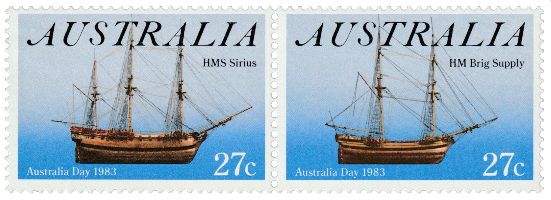
Here are the boats that brought the white people!
So… how does Australia Post go about commemorating a national day that a quarter of Australians consider on the nose?
Is this where the stamp talk starts start again?
Yes. Thanks for sticking with me.
The early Australia Day issues reflected the attitudes of the time. There were a few flag stamps (some I covered here). The 1979 issue (at the top of this page) featured an illustration of the first raising of the Union Jack on Australian soil. (Has any other ‘national day’ stamp in history featured the raising of another nation’s flag? It says everything you need to know about the current debate.)
1984 featured a building called Cooks’ Cottage, which belonged to the father of Captain James Cook, who stepped onto Australia’s east coast in 1770 and declared that it belonged to Britain now. The cottage was shipped from Yorkshire over to Melbourne. You can visit it today, and imagine what it must have been like to be the father of a navigator.
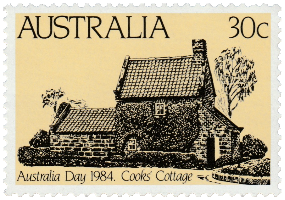
of the white man who decided that Australia belonged to Britain!
Themes of colonialism, settlement, and flags continued until 1984, after which AP started finding more creative ways to mark our official nationalism. This included a 1986 issue featuring an Aboriginal Wandjina spirit protecting the continent, and an attractive golden wattle stamp in 1990.
But not in 1988. 1988 marked the bicentenary of British settlement/invasion/etc. It was a huge philatelic event, with precursor issues from as early as 1984. Credit where it’s due, the first of these was a large issue acknowledging indigenous culture under the moniker ‘The First Australians’.
But the bicentennial issues naturally reached their patriotic climax on January 26, 1988, as a bunch of tall ships sailed into Sydney Harbour and whitey congratulated himself on having been here for 1/325th of his indigenous brothers and sisters. (The issues then continued on through the subsequent years, marking the European spread throughout the land.)

In 1993, Australia Post took a welcome step away from gauche jingoism. Two stamps featuring the (European-style) art of indigenous artist Albert Namatjira were a precursor to four superb years of modern Australian art on stamps, which can wait for a whole blog entry to themselves some day.
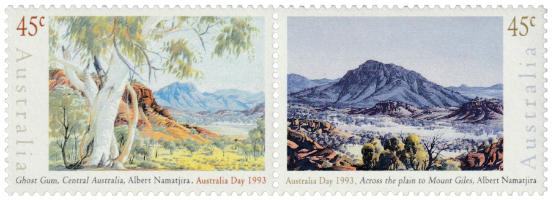
In 1998, Aussie Post began marking Australia Day with an issue known as Australian Legends, honouring an individual or group of notable living Aussies. I wrote a whole blog about it two years ago and you should definitely read it if you didn’t click the link above about the flag stamps. We started with a cricketer, because ‘Straya.
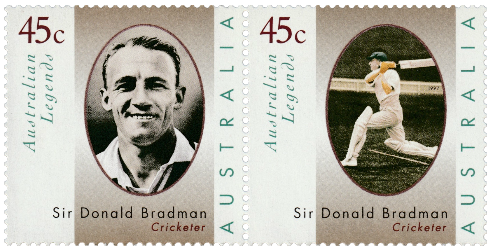
But in 2017, there was no Australian Legends issue on January 26. Aussie Post said the Legends issue would be released at a time more appropriate to the honourees. The remark intrigued collectors (although many of us guessed what was going on).
The answer came at the time of a different anniversary. In May 1967, Australians voted in favour of indigenous Australians being subject to Federal rather than State laws (like every other Australian), and to be included in the population count. Hiding in this legalistic jargon is one simple reality: for the first time, Aboriginal Australians had legal equality with their non-Aboriginal countrypeople.
The 50th anniversary of that referendum was celebrated with its own stamp in May, and it was then that we learned who this year’s Australian Legends were: Tom Calma, Lowitja O’Donoghue and Galarrwuy Yunupingu, three indigenous leaders who were being honoured for their work spanning land rights, economics, self-determination, health, welfare, education and reconciliation.

Those honorees are well deserved, and too bloody right that May was a better time to honour these legends rather than January 26. I applaud Australia Post for that sensitive decision.
I quietly hoped that might have been the culmination of Australia Post’s slow backing away from January 26 as a regular philatelic event. It would have been a good moment to do so. No one would have noticed. It’s not like anyone is queuing up outside post offices for their Australia Day stamps.
January 26 marks the beginning of a long period of conflict and pain, during which Australians killed other Australians. There are plenty of more joyous, more unifying, and, it could be argued, more Australian dates in the calendar of our history.
A poll just this week found that 56% of us don’t care when we have Australia Day, as long as we have it. Tellingly, less than half of respondents even knew why we mark January 26.
Well, my hopes were dashed last week by the bright smiling faces of these Australian TV Legends. Happy Australia Day, Australia! Turn on the TV and nobody mention the war.

If ever a move is made to end Australia Day stamp releases, our resident tub-thumping troglodytes will go off the leash. Hosts of cable TV shows who no one watches will harrumph. People will write into newspapers that no one reads anymore, unlike my blog. The disrespect! The political correctness! The cultural Marxism of it all!
Like many debates in Australia, it will be one more issue where, in the absence of political leadership, we will take our places and yell at each other instead of considering the issues honestly and making meaningful change for the better.
As far as I’m concerned, the history of Australia Day in stamps tells the silliness of the day, and anyone who would complain about no stamps on Australia Day has lost the argument already.
Why? Firstly, because the best we can do for Australia Day now is put Daryl Somers on a stamp.
Secondly, and more damningly, because in 2017, no stamp was released for Australia Day. And no one complained. In fact, other than stamp collectors, no one even noticed.
Whaddya reckon? Drop a comment below! Want to annoy a racist? Share this post on your socials! And meet me on Facebook, Twitter, and Instagram! x
© Philatelic product images remain the copyright of issuing postal administrations and successor authorities

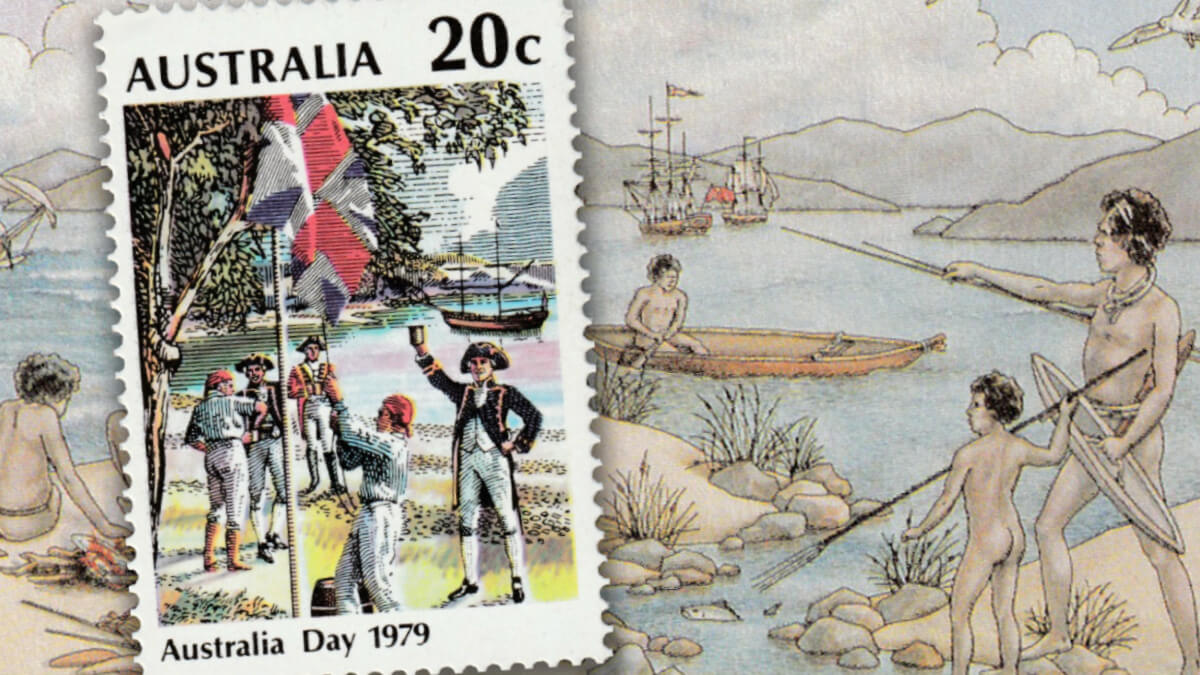
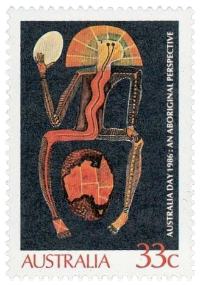
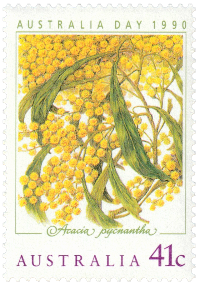
A lot of crimes have been committed in the name of Imperialism.
Look on the bright side…no Robert Menzies and “mother country” and blatant white supremacy. There is an old cavalry saying that you can only move at the pace of the slowest horse in the troop.
And I think that is important in this context. Australia has made some advances (hmmm fair advances) in that theres a debate about the monarchy and the flag and if progress has been frustrating for progressives, there is I think a trend. Conservatives conserve until the point that pragmatism kicks in. But they will use “Australia Day”, royal babies, maybe even ANZAC as a kinda code that binds a particular ethnicity (anglo white) rather than the whole nation in its modern construct of Asian migration and Aboriginal rights.
So its a kinda two steps forward and one step back but its still progress.
Isnt Australia the “lucky country”.
Consider that I live in a no-mans land. I cant even say “Northern Ireland” without emphasising the pronunciation as “Norn Iron” so that nobody can tell if I mean it affectionately or sarcastically. I think its safe to say I detest where I live…where we live separately and emphasise our Irishness thru schools, houses, religion, clubs while others live to emphasise their Britishness.
Our Peace Agreement specifies that we are both right.
I have lectured in USA on Conflict Resolution based on my pretty successful blog site “Keeping An Eye on the Czar of Russia”.
A Peace Agreement that specifies we were all right and all wrong cant work.
Conflict is resolved by victory and defeat….and sadly disputes such as WW2 or Vietnam or South Africa was only resolved by victory and defeat.
And Palestine-Israel?
And Norn Iron.
Nor can USA re-invent itself….as it did with Bush in the White House and President Martin Sheen on TV.
or congratulate itself on Obama in 2008 and think it has reached where it should be….only to elect Trump.
Likewise Australia cant re-invent itself in a supposed “letsgetalongerist” (I coined that phrase in my bloggng) middle ground between “old” Australia of Dame Edna Everage and her gladioli and the “new” Australia of the southern cross ….one will win out and one will lose out….and History is probably on the side of New Australia.
This is a transition.
LikeLiked by 2 people
What a thoughtful post. Thank you John!
LikeLike
Excellent post. Thanks so much.
LikeLiked by 1 person
Thanks Anthony!
LikeLiked by 1 person
Great post. And you’re right…I did not even notice there was no AD stamp issued last year. Personally I hate the divisiveness over this date. I fall more into the conservative camp: I don’t believe changing the date will fix anything and it does nothing to fix the real issues faced by Indigenous Australians. Really enjoyed the tone and humour in your post!
LikeLiked by 1 person
Thanks Linda!
LikeLiked by 1 person
This was a most interesting post for me.
I guess that in every country we have our silliness. The Spanish postal service is now issuing a series (I think it is going to continue) about “discoverers of Oceania”. See, for instance, these stamps from 2017: http://www.correos.es/ss/Satellite/site/coleccion-1363199069252-galeria_sellos_filatelia/detalle_emision-sidioma=en_GB
Happily, there is no issue on the national day, which happens to be the 12 October. I wrote “happily” because “Columbus Day” is started to be seen like it was. In Spain there is a growingly strong movement against, with the slogan “Nothing to celebrate”. So I guess the Philatelic Authorities, who go always in the opposite direction to society, must be thinking of a new 12 October issue…
LikeLiked by 1 person
Thank you Eva! I don’t know how it is in Spain, but we do laugh a bit at ‘discovery’ talk these days. The lands were already discovered, a long time ago… the Europeans only just caught up. 😀
LikeLike
Even if the Australia Day celebration is only meaningful to a minority who respect the daring of the ancestors going out and discovering new places, that does not make it wrong. Everyone should be respected in their heritage.
LikeLiked by 1 person
No, it’s not wrong to respect a person’s heritage, and I personally had some incredibly brave ancestors who took that leap. But do we wilfully ignore all the other stuff the ancestors got up to? It wouldn’t kill us to pick a happier date on which to respect the daring of the brave ancestors without tainting them with the shadow of the murdery ones. Have a look at the interactive map I mentioned in the piece, it’s pretty sobering. Thanks for your comment!
LikeLike